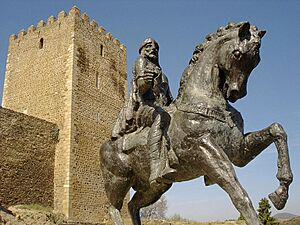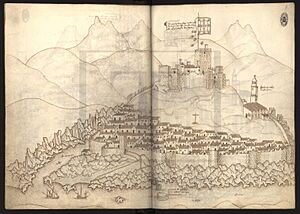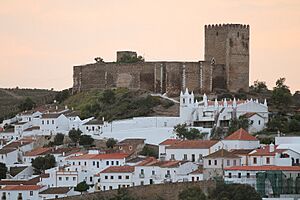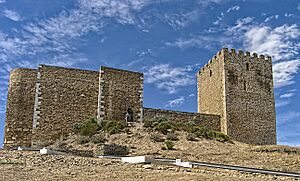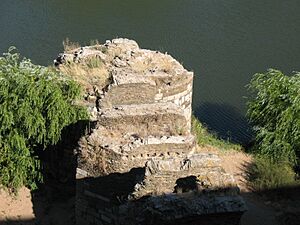Castle of Mertola facts for kids
Quick facts for kids Castle of Mértola |
|
|---|---|
| Castelo de Mértola | |
| Beja, Baixo Alentejo, Alentejo in Portugal | |

A view of the castle as situated on the hilltop, with the mosque/Christian church
|
|
| Coordinates | 37°38′20.4″N 7°39′49.5″W / 37.639000°N 7.663750°W |
| Type | Castle |
| Site information | |
| Owner | Portuguese Republic |
| Operator | Câmara Municipal de Mértola, ceded on 18 January 1941 (adjacent terrains) |
| Open to the public |
Public |
| Site history | |
| Built | 318 B.C. |
| Materials | Stone masonryAlvenaria, Tile, Cornerstone, Taipa |
The Castle of Mértola (Portuguese: Castelo de Mértola) is an old medieval castle. You can find it in the town of Mértola, in the Portuguese district of Beja. This castle has been around for a very long time and has seen many changes. It stands proudly on a hilltop, watching over the area.
History of Mértola Castle
Early Beginnings: Phoenicians and Romans
Long, long ago, around 318 B.C., a group of people called the Phoenicians built a town here. They named it Myrtilis or New Tyre. This area was a busy trading hub. Phoenicians and Carthaginians used its rivers and land routes to trade goods. It was a very important place for business before the Romans arrived.
The Romans later took over and developed the town. It became a center for mining and farming in the Baixo Alentejo region. The Romans built strong walls around Mértola. These walls were much bigger than what you see today. Around 44 B.C., Julius Caesar renamed the town Myrtilis Julia.
Muslim Rule and New Defenses
Later, the town was damaged by invaders. Then, Muslim rulers from the Umayyad Caliphate rebuilt the center. They shortened the name Myrtilis to Martula. A governor named Ibn Qasi likely built new defenses for the castle between 1144 and 1151.
In the mid-1100s, a special building called a ribat was added to the south tower. Later in the 12th century, during the Almohad dynasty, the castle was repaired. New walls were built to protect the whole town. Many of the castle buildings you see today were built or rebuilt during this time. In 1171, Abu Háfece, a brother of the Emir, ordered more repairs and improvements.
Christian Conquest and the Order of Santiago
In 1238, during the Reconquista (when Christian kingdoms took back land from Muslim rule), King Sancho II conquered Mértola. This ended centuries of Islamic rule.
From about 1240 to 1316, Mértola became the main base for the Military Order of Santiago. In 1254, D. Paio Peres Correia gave the region its first foral (a special charter or set of laws). The master of the Order, João Fernandes, ordered the building of the main tower, called the keep tower, in 1292.
Later Improvements and Decline
Towards the end of the 1200s or early 1300s, the castle's dungeons were rebuilt. They used parts of an older gate and tower. More improvements were made to the dungeons and walls in 1373.
In 1386, Mértola and other military areas returned to the Portuguese Crown. This led to more improvements to the castle's defenses in 1404. In the late 1400s, the mayor's house was built next to the keep tower. This meant some of the old walls had to be taken down.
By the 18th century, the Castle of Mértola was still a border defense. However, it slowly lost its military importance. The castle was eventually abandoned. By 1758, it was partly in ruins and had no soldiers guarding it.
Modern Era and Restoration
Between the 19th and 20th centuries, Mértola's economy relied on copper mining. In 1943, the castle was recognized as an important historical site. An earthquake in 1969 caused some damage to the old fortress.
In 1992, the castle came under the care of the Portuguese Institute for Architectural Patrimony. A big project began to bring the site back to life. The castle became part of a "village museum." Different areas show different parts of its history. The keep tower is now a viewpoint and a museum. It displays Roman, Visigothic, Christian, and Islamic items. This includes a great collection of Portuguese Islamic art, like pottery, coins, and jewelry.
Architecture of Mértola Castle
The Castle of Mértola sits on a hilltop in the town. It is built into the rocky landscape near the Guadiana River. Close by is an old Islamic mosque that was later turned into a Christian church.
Castle Towers and Walls
The castle has an irregular, rectangular shape. It features several towers. The main tower, called the keep tower, is rectangular and faces north. There are also two square towers to the south. Two other rectangular towers are near the main gate on the east side. Another rectangular tower has a circular shape.
A "traitors gate" is located in the northwest wall, behind the keep tower. It is protected by a small outer defense called a barbican. The castle walls have battlements, which are the notched tops of the walls. A strong southwestern tower helps support these walls.
The Keep Tower
The Keep Tower is about 30 metres (98 ft) tall. It has a wide base and two floors. A doorway leads to a staircase built against the southeast walls. The tower has decorative bands and openings for dropping things on attackers, called machicolations. It is topped with a parapet and pyramid-shaped merlons.
The first floor holds the weapons hall, with a vaulted ceiling. A staircase on the southern wall leads to the second floor. Next to the keep tower, you can see a carved marble coat-of-arms. This belonged to António Rodrigues Bravo, a postal official.
Other Towers and Features
The Carouche Tower, in the southwest, is a cube-shaped tower about 4.7 metres (15 ft) wide. You can reach it from the battlements. Inside, it has a domed ceiling. The towers at the corners of the main gate have different shapes. One is rectangular, and the other is semi-circular. They are not taller than the main walls.
In the castle courtyard, there is a covered cistern. This is a large tank that collected and stored water. It has a vaulted ceiling supported by three arches.
Town Walls
You can still see parts of the old walls that surrounded the town. They form a rectangular shape, running from north to south. These walls were reinforced with rectangular towers. A large section of the walls is in the north. Most of the walls extend south from the Carocha Tower, with a part running along the Guadiana River. Two ancient gates remain. The Misericórdia Gate provides access to the river.
See also
 In Spanish: Castillo de Mértola para niños
In Spanish: Castillo de Mértola para niños


